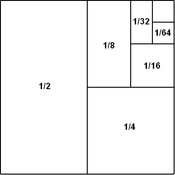| ||||
|---|---|---|---|---|
| −1 0 1 2 3 4 5 6 7 8 9 → ← 0 10 20 30 40 50 60 70 80 90 → | ||||
| Cardinal | one half | |||
| Ordinal | 1⁄2th (halfth) | |||
| Binary | 0.12 | |||
| Ternary | 0.11111111113 | |||
| Senary | 0.36 | |||
| Octal | 0.48 | |||
| Duodecimal | 0.612 | |||
| Hexadecimal | 0.816 | |||
| Greek | ∠ | |||
| Roman numerals | S | |||
| Egyptian hieroglyph | 𓐛 | |||
| Hebrew | חֵצִ | |||
| Malayalam | ൴ | |||
| Chinese | 半 | |||
| Tibetan | ༪ | |||
One half is the multiplicative inverse of 2. It is an irreducible fraction with a numerator of 1 and a denominator of 2. It often appears in mathematical equations, recipes and measurements.
As a word
One half is one of the few fractions which are commonly expressed in natural languages by suppletion rather than regular derivation. In English, for example, compare the compound "one half" with other regular formations like "one-sixth".
A half can also be said to be one part of something divided into two equal parts. It is acceptable to write one half as a hyphenated word, one-half.
Mathematics
One half is the rational number that lies midway between 0 and 1 on the number line. Multiplication by one half is equivalent to division by two, or "halving"; conversely, division by one half is equivalent to multiplication by two, or "doubling".

A number raised to the power of one half is equal to its square root.
The area of a triangle is one half its base and altitude (or height).

The gamma function evaluated at one half is the square root of pi.
It has two different decimal representations in base ten, the familiar and the recurring , with a similar pair of expansions in any even base; while in odd bases, one half has no terminating representation.
The Bernoulli number has the value (its sign depending on competing conventions).
The Riemann hypothesis is the conjecture that every nontrivial complex root of the Riemann zeta function has a real part equal to .
Computer characters
| ½ | |
|---|---|
| vulgar fraction one half | |
| In Unicode | U+00BD ½ VULGAR FRACTION ONE HALF |
| Related | |
| See also | U+00BC ¼ VULGAR FRACTION ONE QUARTER U+00BE ¾ VULGAR FRACTION THREE QUARTERS |
The "one-half" symbol has its own code point as a precomposed character in the Number Forms block of Unicode, rendering as ½.
The reduced size of this symbol may make it illegible to readers with relatively mild visual impairment; consequently the decomposed forms 1⁄2 or 1/2 may be more appropriate.
See also

References
| Fractions and ratios | |||
|---|---|---|---|
 | Division and ratio |  | |
| Fraction |
| ||
 and
and  , where
, where 
 and the
and the  , with a similar pair of expansions in any even
, with a similar pair of expansions in any even  has the value
has the value  (its sign depending on competing conventions).
(its sign depending on competing conventions).
 .
.